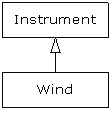Why “upcasting”?
The reason for the term is historical, and based on the way class inheritance diagrams have traditionally been drawn: with the root at the top of the page, growing downward. (Of course, you can draw your diagrams any way you find helpful.) The inheritance diagram for Wind.java is then:

Casting from a derived type to a base type moves up on the inheritance diagram, so it’s commonly referred to as upcasting. Upcasting is always safe because you’re going from a more specific type to a more general type. That is, the derived class is a superset of the base class. It might contain more methods than the base class, but it must contain at least the methods in the base class. The only thing that can occur to the class interface during the upcast is that it can lose methods, not gain them. This is why the compiler allows upcasting without any explicit casts or other special notation.
You can also perform the reverse of upcasting, called downcasting, but this involves a dilemma that is the subject of Chapter 10.
Composition vs.
inheritance revisited
In object-oriented programming, the most likely way that you’ll create and use code is by simply packaging data and methods together into a class, and using objects of that class. You’ll also use existing classes to build new classes with composition. Less frequently, you’ll use inheritance. So although inheritance gets a lot of emphasis while learning OOP, it doesn’t mean that you should use it everywhere you possibly can. On the contrary, you should use it sparingly, only when it’s clear that inheritance is useful. One of the clearest ways to determine whether you should use composition or inheritance is to ask whether you’ll ever need to upcast from your new class to the base class. If you must upcast, then inheritance is necessary, but if you don’t need to upcast, then you should look closely at whether you need inheritance. The next chapter (on polymorphism) provides one of the most compelling reasons for upcasting, but if you remember to ask “Do I need to upcast?” you’ll have a good tool for deciding between composition and inheritance.
